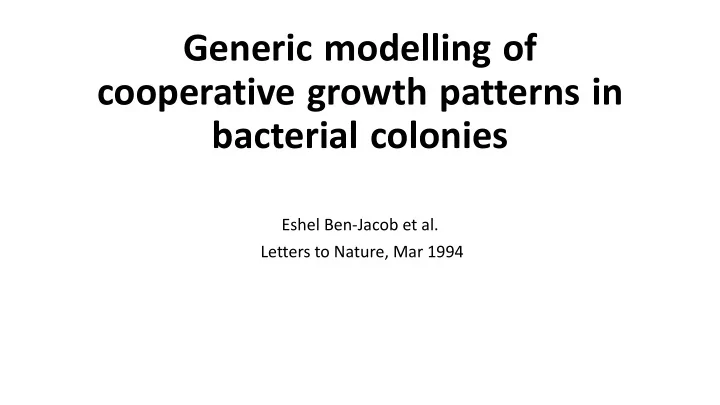

Generic modelling of cooperative growth patterns in bacterial colonies Eshel Ben-Jacob et al. Letters to Nature, Mar 1994
Introduction/ Growth model • Bacteria aggregate to random walkers within an envelope movement along the gradient of nutrient concentration • Cooperative behavior to overcome unfavourable environmental conditionen Communication by means of chemotactic feedback • Growth pattern dependent on environment 12.06.18 2
Experimental Setup • Bacillus subtilis strain 168 : initial value ~ 10 5 • Nutrient: Peptone • Substrat: Agar 12.06.18 3
Growth pattern under variable conditionen 5 g l -1 Decreasing peptone concentration (5– 0.25 g l -1 ) 12.06.18 4
5 g l -1 2 g l -1 Decreasing peptone concentration (5– 0.25 g l -1 ) 12.06.18 5
5 g l -1 0.5 g l -1 2 g l -1 Decreasing peptone concentration (5– 0.25 g l -1 ) 12.06.18 6
5 g l -1 2 g l -1 0.5 g l -1 0.25 g l -1 Decreasing peptone concentration (5– 0.25 g l -1 ) 12.06.18 7
Bacterial movement • Random-like movement within a defined envelope • Propagation of envelope because of collective movement • (f) presumably formed by excretion of chemicals and/or by fluid drawn from agar 12.06.18 8
• Generic features of the bacterial growth model • 1) Diffusion of nutrients Consumption of food by walkers – – r i – location, c r – fixed rate of nutrient consumption • 2) Movement of bacteria Location (r i ) and internal Energy (W i ) determine • the activity e – loss rate of internal energy 3) Reproduction and sporulation Reproduce if W i ~ threshold, sporulate if W i ~ 0 – 4) Local communication Envelope segments move after being hit N c times 12.06.18 9
The communicating walkers model Agar concentration (substrate) Peptone concentration (nutrient) 12.06.18 10
How to achieve dense patterns at low peptone concentrations ? ≠ 12.06.18 11
How to achieve dense patterns at low • peptone concentrations ? • Chemotaxis! • Add chemotactic communication Stationary walkers: production of communication – chemical at fixed rate s r – Active walkers: consumption of communication chemical at a fixed rate c s 12.06.18 12
Effect of Chemotaxis signaling on communicatin walkers model P = 10 g l -1 , Nc =40 Movement changes from pure random-walk (any direction is equiprobable) à a walk along the gradient of communication.
Excursus Morphotypes of bacterial colonies
Morphotypes of bacterial colonies result of cooperative behaviour V(ortex)-Morphotype B(ranching)-Morphotype C(hiral) -Morphotype 12.06.18 15
Morphotype Transitions Grows on softer substrates Grows on hard substrates (higher density of bacteria) B morphotype C morphotype 12.06.18 16
Morphotype Transitions • B-cells on soft agar à morphotype transition and growth bursts of C-cells occurs (after ~ 48hrs) 12.06.18 17
Thank you for your attention! 12.06.18 18
Sources • http://rocs.hu- berlin.de/complexsys2018/pdf/seminarpapers/eshel.pdf • https://pdfs.semanticscholar.org/dbfe/13260289e4ab91a737ec9ff8a af90569f697.pdf • https://www.indiamart.com/proddetail/bacillus-subtilis- 7645289830.html 12.06.18 19
Recommend
More recommend